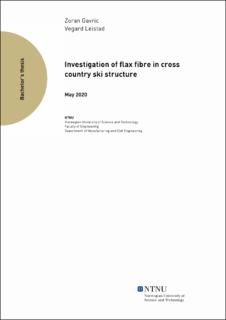Investigation of flax fibre in cross country ski structure
Bachelor thesis

Permanent lenke
https://hdl.handle.net/11250/2661173Utgivelsesdato
2020Metadata
Vis full innførselSamlinger
Sammendrag
Hvordan lage bærekraftige ski? Nedbrytbar biobasert epoxy, PMMA og petroleumsbasert epoxy bletestet med linfiber for å se om dette kunne erstatte dagens glassfiberarmerte petroleumsbasert epoxyi skiproduksjon hos Madshus. Prøvestykkene ble testet i trepunktsbøying og strekkprøvetesting.Videre ble en livsløpseffektanalyse gjennomført for å tydeliggjøre miljøinngrep for et par ski, og forå kunne redegjøre for hvor stor miljøbesparelsen er ved å endre fibertype. Andre komponenter avskistrukturen ble også undersøkt for deres miljøinngrep ved hjelp av livsløpseffektvurdering.Livssyklusanalysens resultater viste en marginal gevinst av å gå over til linfiber fra glassfiber, samtat det største miljøinngrepet ligger i petroleumsbasert epoxy. PMMA matrix ble vurdert som en goderstatning for petroleumsbasert epoxy. Glassfiberarmert petroleumsbasert epoxy hadde bedremekaniske egenskaper på både trepunktsbøying og strekkprøvetesting, enn linfiberarmertekompositter med biobasert epoxy, PMMA og petroleumsbasert epoxy matrix. Naturfiber produsertved konvensjonelt landbruk ble ikke funnet egnet som erstatning for glassfiber i skistrukturen. The thesis explores the possibility of replacing petroleum-based composite materials withrecyclable and potentially more sustainable materials. Synthetic fibers were compared tonatural fiber, where flax fiber may be intendent to replace fiberglass in ski production byfocusing on the mechanical properties of flax fiber. How competitive is flax fiber compared tofiberglass?The use of petroleum-based resin in the industry is widespread. Therefore, properties of thevarious recyclable resin products are examined to enable recycling to be more efficient andless energy intensive, without significantly affecting the mechanical properties of the skis. Byanalyzing the life cycle and environmental impact of the composite materials, it is possible todetermine what combination of materials gives the least environmental impact and comparethis with the mechanical properties.